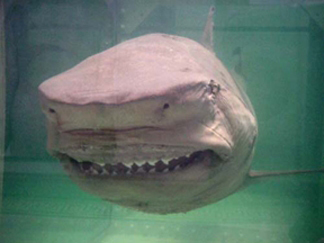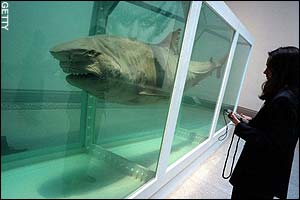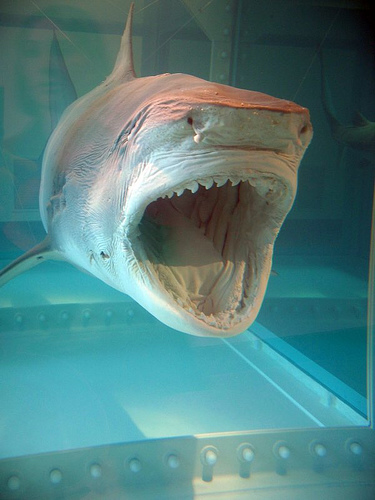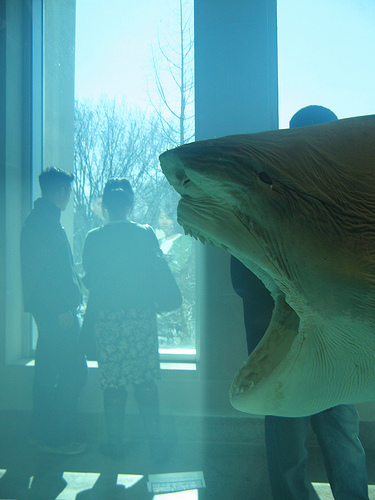Damien Hirst Floating Tiger Shark – “The Physical Impossibility of Death in the Mind of Someone Living.”
The Physical Impossibility of Death in the Mind of Someone Living is an artwork by Damien Hirst.
An English artist and the leading artist of the “Young British Artists” (or YBA).

It consists of a shark preserved in formaldehyde in a vitrine. It was originally commissioned in 1991 by Charles Saatchi, who sold it in 2004, making Hirst the second most expensive living artist after Jasper Johns (he surpassed Johns in 2007).
Due to deterioration of the original 14-foot (4.3 m) tiger shark, it was replaced with a new specimen in 2006. It is on display at the Metropolitan Museum of Art in New York City until 2010.

It is the iconic work of British art in the 1990s, and the symbol of Britart worldwide.
The work was funded by Charles Saatchi, who in 1991 had offered to pay for whatever artwork Hirst wanted to create. The shark itself cost Hirst £6,000 and the total cost of the work was £50,000.
The shark was caught by a fisherman commissioned to do so, in Australia. Hirst wanted something “big enough to eat you”.

But as a result of inadequate preservation efforts, time was not kind to the original, which slowly decomposed until its form changed, its skin grew deeply wrinkled, and the solution in the tank turned murky.

(It didn’t help that the Saatchi Gallery added bleach to the solution, hastening the decay, staff members at Mr. Hirst’s studio said.) In 1993 Mr. Saatchi’s curators finally had the shark skinned and stretched the skin over a fiberglass mold.

“It didn’t look as frightening,’’ Mr. Hirst recalled. “You could tell it wasn’t real. It had no weight.’’
In recent years Mr. Saatchi has been selling off works by the Young British Artists that he collected so voraciously in the 90’s, and two years ago “The Physical Impossibility of Death in the Mind of Someone Living’’ was purchased by the hedge fund billionaire Steven A. Cohen, who lives in Greenwich, Conn. He paid $8 million for it, one of the highest prices at the time for a work of contemporary art.

The impetus was a call from Larry Gagosian, the Manhattan dealer, alerting him to Mr. Saatchi’s intention to sell. Mr. Cohen knew the shark’s history and its problems: that the piece was never properly injected with formaldehyde, and what was floating in the tank was a fiberglass shadow of its former self. But in a funny way, that too had its appeal.

“Is it real? Isn’t it real?’’ Mr. Cohen said. “I liked the whole fear factor.’’
But Mr. Hirst didn’t. When he learned of Mr. Cohen’s plans to buy the 22-ton work, he volunteered to replace the shark. “I frequently work on things after a collector has them,’’ the artist said. “I recently called a collector who owns a fly painting because I didn’t like the way it looked, so I changed it slightly.’’

As it turns out, Mr. Cohen is paying for the replacement project, although he declined to say how much it would cost, other than to call the expense “inconsequential.’’ (The procedure involving the injection of formaldehyde alone adds up to about $100,000, including labor and materials.)

Mr. Hirst began by contacting his shark sources in Australia. And a year ago he bought the second tiger shark, this one from a fisherman who caught it just off the Queensland coast and killed it. It was shipped by sea freighter in a special 20-foot freezer with backup power, a journey that took roughly two months. Meanwhile the original tank was being renovated.
PURPOSELY provocative and sometimes disturbing, Mr. Hirst is probably Britain’s most controversial artist. Lines form around the block at gallery openings of his work, and fans often shout when they recognize him in the street. Some art critics praise him for acquainting a young generation with conceptual art nearly a century after Marcel Duchamp unveiled his porcelain urinal; other critics deride him as an artist of gimmicks and one-liners. In 1995, when he won Britain’s prestigious Turner Prize for “Mother and Child Divided,’’ a cow and a calf cut into sections and exhibited in a series of vitrines, Brian Sewell of The Evening Standard of London wrote that it was “no more interesting than a stuffed pike over a pub door.’’

Reportedly one of the richest men in Britain, Mr. Hirst can now afford to run multiple studios in London and in Gloucestershire, some two hours west of the capital, equipped with freezers full of dead animals and emergency generators in case of a power failure.
Such is his reputation that when a seven-foot shark washed up on a beach in July, and the Natural History Museum in London needed a place to store it until its staff was ready to preserve it, the first call it made was to Mr. Hirst.
“They asked if I had any room in my freezer,’’ he said with satisfaction. He was happy to oblige.
Oliver Crimmen, a scientist and fish curator at the Natural History Museum in London, was in the formaldehyde pool with the shark, directing the operation. Mr. Hirst had enlisted his help to ensure that this specimen would last longer than its predecessor. “It’s like cookery,’’ Mr. Hirst mused. “There are loads of recipes.’’
Mr. Crimmen is experienced mainly in preserving fish like giant squid and swordfish. “Normally the fish I work on are smaller,” he said, “so I have adapted the recipe to the shark’s weight, which is 1.92 metric tons. It is critically important to make sure the fluid penetrates all the tissues.’’
During a short lunch break, over sandwiches and soft drinks, Mr. Crimmen explained the procedure. The shark — a female about 25 to 30 years old, middle-aged in shark terms — would spend about two weeks in a bath filled with a 7 percent formalin solution, made of dissolved formaldehyde gas and water.
“There are places you cannot reach with needles, like its fin, skull and the spinal column,’’ Mr. Crimmen said. So the shark is immersed in the bath to allow the formaldehyde to be absorbed through the skin. The mission required 34 barrels — each containing 6.6 gallons— of formaldehyde. At night a lid is put over the pool, and the shark is left to marinate.
“You have to have a carefully mapped injection program,’’ Mr. Crimmen said. “There are no nice tests to see if the formaldehyde has been properly absorbed deep inside the shark. You have to see how the specimen behaves to the touch. If it is hard when manipulated and bent, it means it has properly penetrated into the animal’s body tissues.’’
Unlike most fish, the scientist explained, sharks do not have bony skeletons; theirs are made of cartilage, which is relatively flexible. “Even their jaws, which you might think are made of bone, are actually made of hard cartilage, which has a limited life span and can crumble over time,’’ Mr. Crimmen said. So if the body is to last for decades, the shark must be kept constantly moist in the formalin solution.
A shark’s skin is armored with tiny teeth, so Mr. Crimmen and his team had to first drill small holes in the skin, filling them with temporary pins in preparation for the injection of the formaldehyde. Because a shark’s skin is so rough, the tiny holes won’t leave noticeable marks once the fish is properly preserved.
“As a fish curator I generally preserve things for science and then I don’t have to pay attention to aesthetics,’’ Mr. Crimmen said. “This is a novel angle for me.’’
After lunch Mr. Crimmen returned to the formaldehyde pool with five workers from Mr. Hirst’s studio, the rap music still softly playing in the background. Only Mr. Crimmen spent the entire day attending to the shark; the environment was so unpleasant, the workers said, that most of them could bear to be there for only a few hours at a time.
By now the shark had been turned on its side and the process of removing the temporary needles and injecting the animal had begun. Once the shark has totally absorbed the formalin and formaldehyde, it will be taken in a specially designed shark-shaped traveling tank to Bregenz, Austria, for an exhibition that begins in February. (Its original 1991 tank has been refurbished for the occasion.) Sometime in the summer the shark will make its way to Mr. Cohen’s house in Greenwich.
ON a recent Saturday afternoon Mr. Cohen was in Manhattan taking in the latest gallery exhibitions. He had stopped by the Gagosian Gallery on Madison Avenue to see some drawings by Mr. Hirst that had just gone on view. On the walls were studies for “The Physical Impossibility of Death in the Mind of Someone Living,’’ prompting Mr. Cohen to reminisce about the first time he found himself face-to-face with the real piece.
“It was in County Hall in London,’’ Mr. Cohen said. “I grew up in the generation of ‘Jaws.’ I knew it was the piece of the 90’s.’’
Mr. Hirst acknowledges that once the shark is replaced, art historians will argue that the piece cannot be considered the same artwork. “It’s a big dilemma,’’ he said. “Artists and conservators have different opinions about what’s important: the original artwork or the original intention. I come from a Conceptual art background, so I think it should be the intention. It’s the same piece. But the jury will be out for a long time to come.’’
Echoing that argument, Mr. Cohen said the shark could not be compared to a painting. “We’re dealing with a conceptual idea,’’ he said. “The whole point is the boldness of the shark. Damien felt strongly that this was the best option.’’
Rumors have circulated in the art world that Mr. Cohen has promised the work to the Museum of Modern Art. But Mr. Cohen said that he had made no plans to donate the work to the Modern and that he is unsure exactly where he will put it when the tank arrives in Connecticut.
“Ultimately I think it’s a piece that needs to be put in a major museum,’’ he said. “I’ve had discussions with some, but I can’t say which ones, and nothing has been decided.’’
More generally his long-term plans include building a private museum on his property in Greenwich to display his art collection, from a Manet self-portrait to Monet’s “Water Lilies’’ to a Jackson Pollock drip painting to Pop Art by Warhol and Lichtenstein. He also owns Mr. Hirst’s “Away From the Flock,’’ a whole lamb floating in a formaldehyde solution, as well as several paintings by Mr. Hirst, among them examples of his signature butterflies, pills and a skull.
As for the future of the new shark, Mr. Hirst isn’t worried, he said.
“As long as it lasts my lifetime, I’m happy,’’ he said. After a pause, he added: “It’s got a 200-year guarantee. Or your money back.’’

November 27, 2012 at 6:50 pm
Damien Hirst himself is a piece of art ,no one can deny that, also the fact it was a tiger shark , because tiger sharks r less easy to handle, but i personally belive that his work is extremly cruel to the enviroment. well how would u like it if someone killed u and used it for a work of art? there r many forms of art in the world why does he have to chose to be enviromentally crueel!